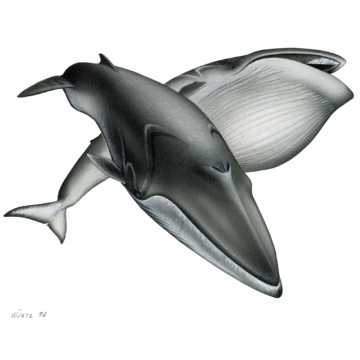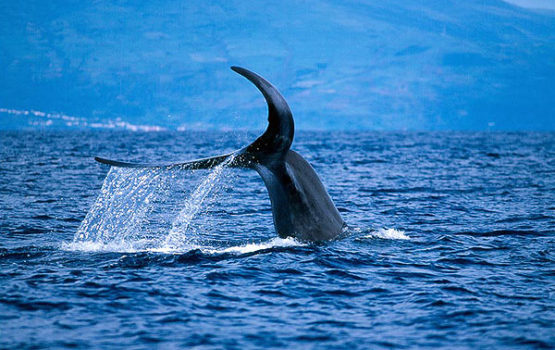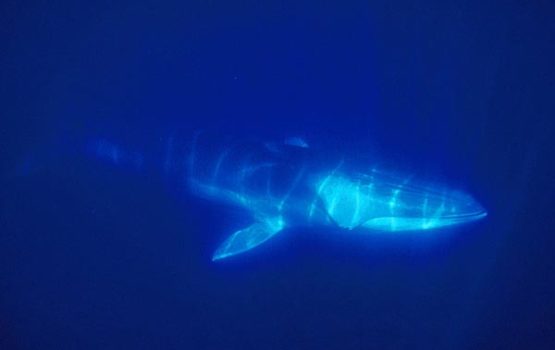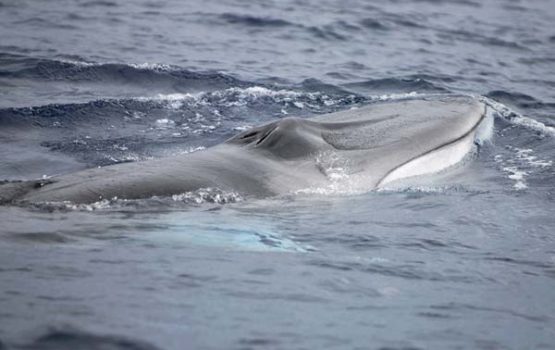Newborn fin whales are 6.5m long and weigh about 2500kg. The maximum measurements for this species is about 25m in the Northern Hemisphere and 27m in the Southern Hemisphere, with males slightly shorter (less 2m) than females. Their weight can be close to 150tonnes. There are 260-480 baleen plates on each side of the mouth. The baleen are dark grey to black in colour, except in the front third of the right side which are yellow or cream-coloured, approximately 0.9m long. The life span is, at least, 80years.
Fin whales are the second largest animal ever known; their bodies are dark grey above and white below, although most individuals have a lighter blaze on the right side, expanding to the back. The flukes are bordered with grey underneath. The characteristic asymmetrical colouration of the lower jaw – black on the left, white on the right – is present in only one other species, the Omura’s whale (Balaenoptera omurai). From above, the head is V-shaped. The ventral pleats extend at least to the umbilicus and number 50 to 100. The dorsal fin is large and set far back on the body, rarely seen at the same time as the blowholes when the whale surfaces. The fin whale’s blow is tall and columnar, often reaching 8m in height.
Fin whales feed on krill and various small schooling fish. They feed by lunging into prey schools. Some of these lunges may involve bursts of speed of up to 25 knots (~40km/h). It is extremely rare that they raise their flukes during a dive. Short dives are usually more common, varying between 8-15min. Like other mysticetes, fin whales are usually found travelling alone, or in small groups, although large unassociated aggregations have been reported on feeding grounds. Calving takes place in winter, probably in tropical and subtropical water after a gestation period of about 11-12months. Hybrids between blue (Balaenoptera musculus) and fin whales have been described. They usually migrate in spring and autumn, altering between nursing grounds in the winter and foraging grounds in the summer. Usually these foraging grounds are in cold, polar and temperate waters.
Fin whales are the second largest animal ever known; their bodies are dark grey above and white below, although most individuals have a lighter blaze on the right side, expanding to the back. The flukes are bordered with grey underneath. The characteristic asymmetrical colouration of the lower jaw – black on the left, white on the right – is present in only one other species, the Omura’s whale (Balaenoptera omurai). From above, the head is V-shaped. The ventral pleats extend at least to the umbilicus and number 50 to 100. The dorsal fin is large and set far back on the body, rarely seen at the same time as the blowholes when the whale surfaces. The fin whale’s blow is tall and columnar, often reaching 8m in height.
Fin whales feed on krill and various small schooling fish. They feed by lunging into prey schools. Some of these lunges may involve bursts of speed of up to 25 knots (~40km/h). It is extremely rare that they raise their flukes during a dive. Short dives are usually more common, varying between 8-15min. Like other mysticetes, fin whales are usually found travelling alone, or in small groups, although large unassociated aggregations have been reported on feeding grounds. Calving takes place in winter, probably in tropical and subtropical water after a gestation period of about 11-12months. Hybrids between blue (Balaenoptera musculus) and fin whales have been described. They usually migrate in spring and autumn, altering between nursing grounds in the winter and foraging grounds in the summer. Usually these foraging grounds are in cold, polar and temperate waters.
Fin whales are a cosmopolitan species occurring in all oceans and inhabiting coastal and oceanic waters. They also occur in the Mediterranean Sea. Due to their size and distribution, they could be confused with blue whales, however with good light conditions it is possible to see that blue whales have lighter bodies and tiny dorsal fins, a feature we use to distinguish between the two species in poor light conditions or at a distance. They could also be confused with Sei whales (Balaenoptera borealis), however, due to the position of the dorsal fin set anteriorly for the Sei whales, it is usually possible to spot the blow and dorsal fin simultaneously at the surface.
This is a seasonally frequent sighted species in the Azores. Until recently this species was sighted in 7% of our trips at sea. However, since 2014 there has been a significant increase in the sightings of these animals raising it to 35% since that year. This could be due to an increase in the number of individuals in the North Atlantic, but also due to the change in their migration routes, passing closer to shore in the south of Pico. The sightings begin in March and usually go until July, however the majority of the sightings occur in April and May. In recent years there are sporadic sightings throughout the entire season. We usually encounter them either feeding (more erratic in their surface patterns and submerging longer) or resting (usually travelling slowly close to the surface and often showing curiosity towards boats).
This is a seasonally frequent sighted species in the Azores. Until recently this species was sighted in 7% of our trips at sea. However, since 2014 there has been a significant increase in the sightings of these animals raising it to 35% since that year. This could be due to an increase in the number of individuals in the North Atlantic, but also due to the change in their migration routes, passing closer to shore in the south of Pico. The sightings begin in March and usually go until July, however the majority of the sightings occur in April and May. In recent years there are sporadic sightings throughout the entire season. We usually encounter them either feeding (more erratic in their surface patterns and submerging longer) or resting (usually travelling slowly close to the surface and often showing curiosity towards boats).
PT: Baleia comum / AZORES: Finbeque
ENG: Fin whale
FR: Rorqual commun
DE: Finnwal
IT: Balenottera comune
ESP: Rorcual común
NL: Gewone vinvis
ENG: Fin whale
FR: Rorqual commun
DE: Finnwal
IT: Balenottera comune
ESP: Rorcual común
NL: Gewone vinvis



